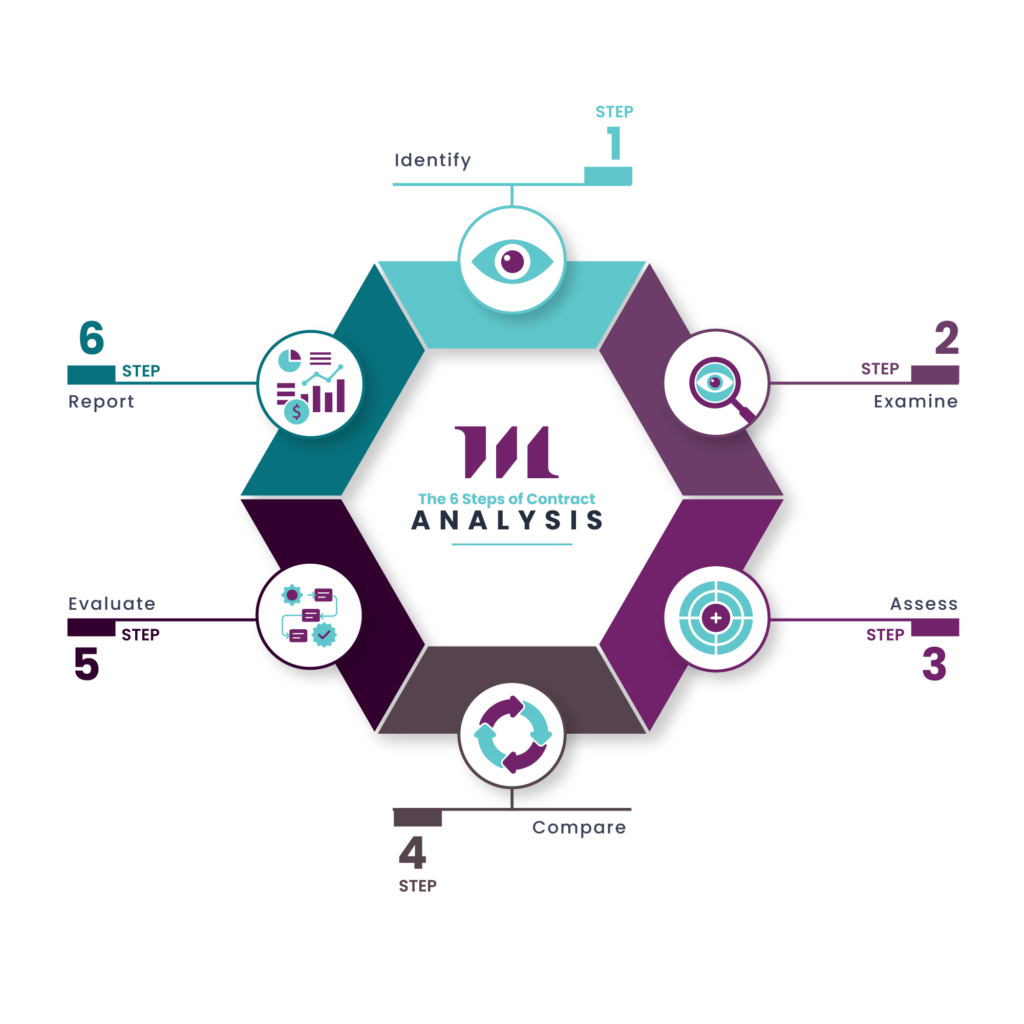Contract Analysis – Gain & Leverage Insight from Contracts
Despite their pivotal role, the valuable insights buried within contracts often go untapped. This is a missed opportunity because contracts are data-rich assets that can provide organizations with a competitive edge when analyzed effectively through contract analytics.
The reality is that a staggering 70% of companies fail to fully adhere to the terms and conditions laid out in their contracts. This oversight exposes businesses to significant legal and financial risks that could have been mitigated through proper contract analysis. Whether due to lack of visibility, inefficient processes, or sheer ignorance, not leveraging the wealth of information encapsulated in contracts is a costly mistake.
Comprehensive contract analysis allows organizations to extract actionable intelligence from these critical documents. By scrutinizing key contractual elements such as pricing, deliverables, renewal dates, and compliance requirements, businesses can identify areas of exposure, pinpoint opportunities for optimization, and make informed decisions that drive growth and profitability.
What is Contract Analysis?
Contract analysis is the ongoing process of reviewing and evaluating contractual agreements to extract key information and insights. It involves scrutinizing various elements such as terms, conditions, pricing, deadlines, and compliance requirements across the contract’s lifecycle. This practice differs from contract review, which typically occurs before a contract is signed and focuses on assessing the suitability of the proposed terms.
While a contract review usually means a one-time evaluation, the process of contract analysis is a continuous activity that leverages contract analysis systems to monitor and analyze contracts over time. The goal is to gain a comprehensive understanding of the contract’s implications, identify potential exposure or opportunities, and ensure adherence to its stipulations.
Throughout the contract lifecycle, which spans creation, negotiation, execution, and renewal/termination, contract analysis plays a vital role. During the drafting phase, it helps ensure that the proposed terms align with the organization’s interests and policies. As negotiations progress, analysis of the evolving contract enables informed decision-making and strategic positioning.
Post-execution, contract analysis systems facilitate the tracking of performance metrics, financial obligations, renewal dates, and compliance standards. This proactive approach mitigates the risk of missed deadlines, costly penalties, or legal disputes arising from non-compliance. When it comes time for renewal or termination, a thorough analysis of the contract’s performance and evolving business needs guide the appropriate course of action.
By maintaining a robust contract analysis process, organizations can unlock the full potential of their contractual agreements. They gain the ability to spot inefficiencies, mitigate risks, capitalize on opportunities, and drive continuous improvement in their contracting practices – ultimately enhancing their competitive edge and bottom line.
How Your Business Benefits from Contract Analysis
Implementing a robust contract analysis strategy yields numerous benefits that span multiple facets of an organization’s operations. Here are some of the key advantages.
Improved Decision Making
Contract analysis provides a comprehensive view of the performance, risks, and opportunities associated with contractual agreements. By having access to this wealth of data and insights, executives and decision-makers can make more informed choices that are grounded in factual evidence rather than assumptions. This data-driven approach leads to better strategic planning, resource allocation, and overall business guidance.
Risk Mitigation
A thorough contract analyzer can pinpoint areas of potential legal, financial, or operational exposure before they manifest into larger issues. For instance, it may uncover ambiguous clauses that leave room for dispute, liabilities that expose the company to lawsuits, or compliance gaps that could result in hefty penalties. With this knowledge, organizations can proactively address and mitigate these exposures, safeguarding their interests and reputation.
Cost Savings
By analyzing contract performance data, such as service delivery metrics and payment terms, businesses can identify opportunities for cost optimization. A contract intelligence solution may reveal instances of overpayment, unmet service level agreements, or inefficient procurement practices, enabling corrective action. Furthermore, minimizing legal disputes and associated penalties through effective contract governance contributes to significant cost savings.
Enhanced Compliance
Regulatory landscapes are constantly evolving, and failure to adapt can result in non-compliance penalties, litigation, and reputational damage. Contract analysis ensures that agreements remain compliant with the latest laws, industry standards, and internal policies. It facilitates the identification and remediation of any compliance gaps, providing peace of mind and protecting the organization’s interests.
Stronger Negotiations
A contract analysis example that compares past agreements and their outcomes can reveal valuable insights into negotiation strategies. By understanding which terms and clauses have historically led to disputes, delays, or financial losses, negotiators can enter future discussions better prepared and positioned to secure more favorable terms for the business.
Improved Contracting Processes
The data and lessons learned from contract analysis feed into the continuous improvement of an organization’s contracting practices. It highlights areas where standardized templates, clause libraries, or workflow optimizations could streamline the process, reduce errors, and enhance efficiency.
Contract Analysis Process & Best Practices
The process of contract analysis is a multi-faceted endeavor that involves several important steps to ensure a comprehensive and effective evaluation of contractual agreements. Although specific approaches may vary by industry and company, a well-structured contract analysis generally follows a methodical process.

Step 1 – Identification of Key Terms and Provisions
The first step involves carefully reviewing the contract to pinpoint and extract critical elements such as pricing structures, delivery timelines, service level agreements (SLAs), payment terms, renewal dates, termination clauses, and other vital components. This initial phase lays the foundation for subsequent analysis by establishing a clear understanding of the contract’s core elements.
Step 2 – Examination of Legal and Business Risks
With the key terms identified, the next step is to assess the potential legal and business risks associated with each provision. This includes evaluating the clarity and enforceability of clauses, identifying ambiguities or loopholes that could lead to disputes, and assessing the potential financial and operational implications of non-compliance or breach of contract.
Step 3 – Assessment of Compliance Requirements
Contracts often involve various regulatory, industry-specific, and internal policy compliance obligations. During this phase, analysts scrutinize the agreement to ensure that it adheres to all relevant laws, standards, and guidelines. Any deviations or gaps are flagged for further review and potential remediation.
Step 4 – Comparison to Standard Templates and Previous Agreements
Benchmarking the contract against standard industry templates, internal clause libraries, and previously executed agreements can reveal valuable insights. This step helps identify deviations from established norms, highlights areas for potential negotiation, and ensures consistency across the organization’s contracting practices.
Step 5 – Performance Metric Evaluation
For existing contracts, it is crucial to analyze their performance against predefined metrics and key performance indicators (KPIs). This may include evaluating service delivery quality, adherence to timelines, financial obligations, and overall value realization. This analysis informs decisions regarding contract renewals, renegotiations, or terminations.
Step 6 – Reporting and Actionable Insights
The final step involves synthesizing the findings from the analysis into clear and actionable insights. This may include generating reports, visualizations, or dashboards that highlight areas of concern, opportunities for improvement, and recommendations for future action.
To ensure the effectiveness and efficiency of the contract analysis process, it is essential to adopt best practices that align with industry standards and leverage advanced technologies.
Establish Standard Operating Procedures (SOPs)
Implementing well-defined and consistent procedures for contract analysis ensures uniformity, minimizes errors, and facilitates collaboration across teams and departments. SOPs should cover aspects such as data collection, analysis methodologies, reporting formats, and escalation protocols.
Leverage Artificial Intelligence (AI) and Contract Analysis Tools
Modern contract analysis software, powered by AI and natural language processing (NLP) capabilities, can significantly streamline and automate various aspects of the analysis process. These tools can extract key terms, identify, assess compliance, and generate insightful reports, reducing manual effort and minimizing human error.
Integrate with Enterprise Systems
Seamless integration of contract analysis tools with existing enterprise systems, such as customer relationship management (CRM), enterprise resource planning (ERP), and document management systems, facilitates data sharing and enhances visibility across the organization.
Provide Comprehensive Training
Investing in comprehensive training programs for legal teams, contract managers, and other stakeholders is crucial. Training should cover not only the technical aspects of contract analysis but also best practices, industry-specific nuances, and the effective utilization of available tools and technologies.
Collaboration and Knowledge Sharing
Encouraging cross-functional collaboration and knowledge sharing among teams involved in the contract analysis process can lead to valuable insights and continuous improvement. Regular meetings, knowledge-sharing sessions, and feedback loops can help identify areas for optimization and promote a culture of continuous learning.
Overcoming Key Challenges with Contract Intelligence
While the benefits of comprehensive contract analysis are undeniable, organizations often face hurdles such as high contract volumes, complex legal language, inconsistencies across agreements, and data integration issues. Modern AI-powered contract analysis software provides the right tools to overcome these obstacles.
One of the most significant challenges is the sheer volume of contracts that businesses, especially large enterprises, must manage. Manually reviewing and analyzing thousands of agreements is a daunting and time-consuming task, prone to errors and inefficiencies. This is where AI contract analysis tools excel.
By leveraging natural language processing and machine learning algorithms, these smart contract analysis tools can rapidly ingest and analyze vast quantities of contracts, extracting key data points and identifying potential or compliance issues with unparalleled speed and accuracy.
The complex and intricate nature of legal language presents another obstacle. Contracts are often riddled with technical jargon, ambiguous phrasing, and convoluted clauses that can be challenging for humans to interpret consistently. AI-powered contract intelligence software is specifically trained to decode and comprehend this complex legal language, ensuring that critical information is not overlooked or misinterpreted.
Inconsistencies across contracts can also pose a significant challenge, particularly for organizations with decentralized contracting processes or those that have undergone mergers or acquisitions. Contract intelligence software employs advanced algorithms to identify and flag inconsistencies, enabling legal teams to proactively address them and maintain uniformity across their contract portfolio.
Data integration is another common hurdle, as contract data is often siloed across multiple systems and departments within an organization. AI-driven contract analysis tools offer robust integration capabilities, seamlessly connecting with existing enterprise systems such as customer relationship management (CRM), enterprise resource planning (ERP), and document management platforms. This ensures a seamless flow of data, fostering collaboration and enabling cross-functional visibility into contract information.
While each agreement type can present its own challenges, Mergers and Acquisitions (M&A) processes present a daunting difficulty: rapidly assessing a target company’s vast array of diverse contracts. AI-powered contract intelligence software is a game-changer in this situation, providing a centralized repository that brings order to chaos and enables swift analysis. These tools identify risks, offer insights into financial health, provide a comprehensive view of contractual relationships, and assess overall compliance, thereby mitigating risks and ensuring M&A success.
How Can Malbek Support Contract Analysis Efforts
Companies facing the challenges of large contract volumes, complex legal language, inconsistencies between different contracts, and data integration issues will find Malbek a powerful ally for streamlining contract analysis. It uses artificial intelligence (AI) and Generative AI (Gen AI), capabilities to automate and improve various aspects of the contract analysis process.
With Malbek, companies can harness the power of AI to quickly extract and analyze key data points from contracts, such as pricing structures, delivery dates, renewal dates, and compliance requirements. This automated data extraction not only saves valuable time but also eliminates the risk of human error that can occur with manual processes.
Beyond data extraction, Malbek’s AI-driven capabilities also provide the ability to identify potential, detect compliance issues, and provide insights into negotiation strategies. By using advanced algorithms and trained models, the platform can detect ambiguous clauses, assess the impact of proposed changes, and even suggest optimized contract structures tailored to the company’s specific needs and guardrails.
In addition, Malbek provides robust analytics and reporting capabilities that enable legal teams to create comprehensive visualizations to highlight key performance indicators, trend analysis, and actionable insights. These data-driven insights enable organizations to make informed decisions, optimize their contracting processes, and achieve strategic business outcomes.
One of Malbek’s standout features is its seamless integration with existing enterprise systems through no-code, drag-and-drop connections. By fostering a seamless flow of contract data across the organization, Malbek promotes cross-functional visibility and collaboration, positioning legal teams as strategic value creators rather than perceived bottlenecks.
In summary, Malbek’s AI-driven contract analytics capabilities enable organizations to overcome the hurdles posed by large contract volumes, complex legal language, inconsistencies, and data silos to unlock new efficiencies, mitigate risk and gain a formidable competitive advantage in an increasingly complex business landscape.
FAQs
What is the difference between contract analysis and contract review?
Contract review is a one-time evaluation that occurs before a contract is signed, focusing on assessing the suitability of the proposed terms. In contrast, contract analysis is an ongoing process that involves reviewing and evaluating contracts throughout their lifecycle to extract key information, identify exposure risks, and ensure compliance.
Why is contract analysis important for businesses?
Contract analysis enables organizations to unlock valuable insights from their contractual agreements. It helps mitigate risks, optimize costs, ensure compliance with legal and regulatory requirements, and strengthen negotiation strategies, ultimately driving better decision-making and enhancing overall business performance.
How can AI and modern software help with contract analysis?
AI-powered contract analysis tools leverage natural language processing and machine learning to automate tasks like data extraction, exposure identification, and compliance monitoring. These advanced software solutions can rapidly analyze vast quantities of contracts, decode complex legal language, and provide robust analytics, streamlining the entire process.
What are some best practices for effective contract analysis?
Best practices for effective contract analysis include establishing standardized procedures, leveraging AI and modern contract analysis software, integrating with existing enterprise systems, providing comprehensive training to staff, and fostering collaboration and knowledge-sharing across teams involved in the contracting process.
Conclusion
By strategically implementing AI-powered contract analysis tools and best practices, organizations can overcome challenges posed by high contract volumes, complex legal language, inconsistencies, and data integration issues. With automated data extraction, exposure identification, compliance monitoring, and robust analytics capabilities, businesses can make informed decisions, streamline contracting processes, and drive strategic outcomes.
Key Takeaways:
- Contract analysis transforms static agreements into dynamic sources of business intelligence.
- AI and advanced contract analysis software enable organizations to extract actionable insights from their contract portfolio efficiently.
- Implementing best practices, such as standardized procedures and staff training, enhances the effectiveness of contract analysis efforts.
- Integrating contract analysis tools with existing enterprise systems fosters collaboration and enables cross-functional visibility into contract data.
- Comprehensive contract analysis empowers organizations to gain a competitive edge by optimizing performance, mitigating risks, and driving informed decision-making.
By embracing the power of contract analysis, businesses can unlock the true value of their contractual relationships and position themselves for long-term success in an increasingly complex and data-driven business environment.







